
Sesame Plant
to Oil
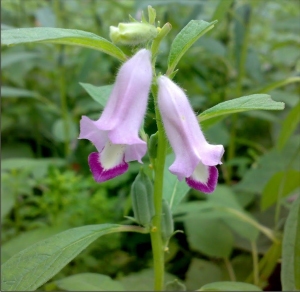
Generally, Sesame Plant is 3-5 feet tall; and, with good moisture and fertility, it can reach 5-6 feet.
Flowering starts about 35-45 days after planting, typically setting two new flowers per day. Sesame is indeterminate but generally flowering stops after 75-85 days.

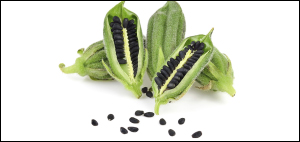
The fruiting form is called a capsule. The first capsule is about 1-2 ft above the ground. Capsules are divided by carpels like a cotton boll. There are 4 rows of seeds in each capsule with about 70 seeds produced in each capsule.
The plant is very leafy and succulent prior to physiological maturity (PM) which normally occurs 95-110 days after planting. PM is when 75% of the capsules on the main stem have mature seed. Normally, sesame will self-defoliate by full maturity and drydown 120-150 days after planting.

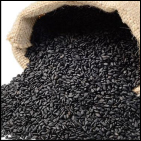
The seeds are oil rich (about 50 -60%) and hence cannot be stored in large quantities for a long time as the seeds will quickly get rancid.

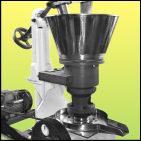
Mature seeds are cleaned and extracted.


Unlike seeds, Sesame oil has a remarkable shelf life of more than a year
Sesame Oil
One of the oldest homegrown plants on earth and an essential component of traditional food and medicine, sesame is indeed nature’s gift to mankind.
Sesame is obtained from the pods of the tropical plant 'Sesamum indicum', which has its origins in
India and Africa. Sesame seeds contain up to 55 percent oil and 20 percent protein, and are a rich source of cholesterol- reducing phytonutrients, protein and amino acids. They are thus a major source of edible oil in India and many other Asian countries.
Natural Sesame oil extracted from good quality seeds has a very pleasant flavour and can be consumed without further purification. High levels of natural antioxidants such as Sesamin and Sesamol are resent in natural sesame oil, making it the most healthy and tasty edible oil.
In India, Sesame/ Gingelly oil is known as Til oil, – derived from the Sanskrit word 'Tila' meaning sesame. Throughout south India, people call it 'good oil' - ('nallennai' in TamilNadu, 'ellenne' in Karnataka, 'nuvvula noone' or 'manchi noone' in Andhra Pradesh and 'nallenna' in Kerala.
With its natural nourishment and rich, nutty flavour, Sesame oil is a traditional component in Asian cuisines and an essential part of every Indian kitchen.
[ultimate_spacer height=”50″]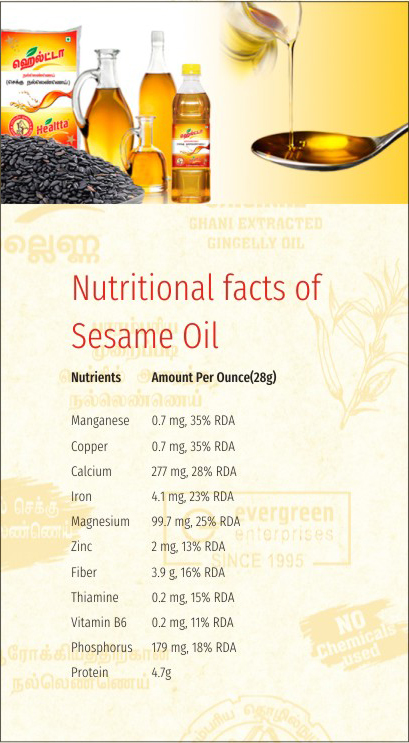
Culinary uses of
Sesame Oil
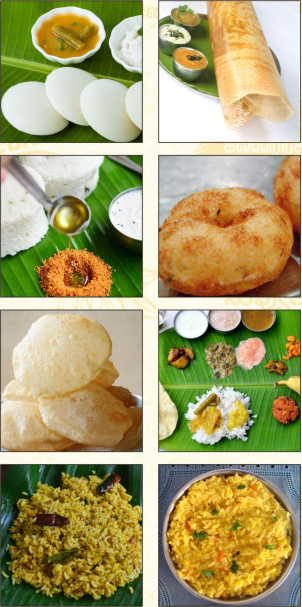
When making fried food at home, just adding 30% Sesame oil to your frying oil makes the dish more fragrant. In addition, since sesame oil is comparatively difficult to oxidize, adding it to your frying oil prolongs not only the life of the frying oil, but also the palatability of your dish.
If you use Sesame oil for stir-frys, the fragrant sesame aroma will stimulate your appetite.
Adding a hint of Sesame oil to the water when boiling green vegetables makes the color more vivid.
You can even try to make your original sesame oil recipes using the taste, flavor and aroma of Sesame oil!
Medicinal uses of
Sesame Oil

Sesame oil is the traditional oil of choice for abhyanga, the daily ayurvedic self-massage. It is rich in linoleic acid, and has anti-bacterial, anti-inflammatory and antioxidant property. Sesame oil is especially useful for pacifying Vata.
Sesame oil is used as the base for most of the herbal oils. It is very nourishing, and prevents the skin from getting excessively dry.

